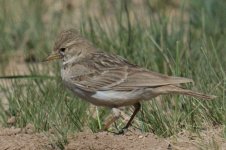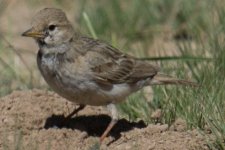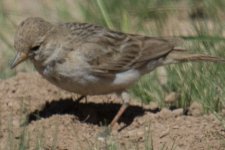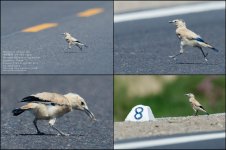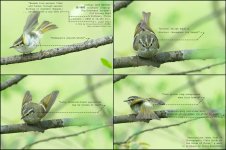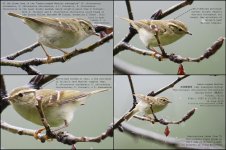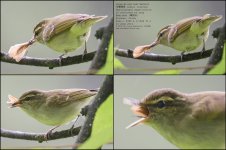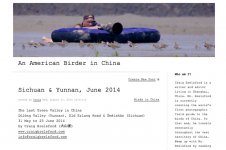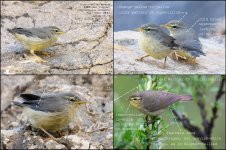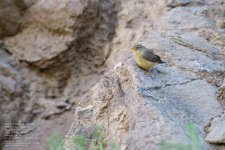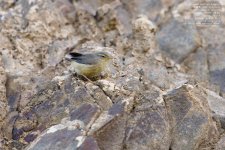Hi Craig - weak flying Juvenile birds, in their attempts to keep out of the claws and talons of predators may often show terrestrial behavior thats not normally associated with adults. As for an ID on your birds I'd actually swing towards Buff-throated over Alpine - but with many juvenile LBJ's, especially leaf-warblers, making a certain call without seeing and preferably hearing adults - is always a difficult job.
You're disappointing me, Sid. Although you didn't actually witness the birds as I did, my ID is based not only on direct evidence but very much also on circumstantial evidence, logic, and the literature. You have just as much access to the literature as I, and as a longtime birder, you must use circumstantial evidence and logic to achieve your IDs.
I know how to ID birds and know when to limit my listing to "
Phylloscopus sp." However, in this case, having studied the literature, examined the circumstantial evidence, and applied logic, I can (and you should) confidently "lock in" on Sulphur-bellied Warbler
P. griseolus.
My prime piece of literature in this case is HBW 11, probably the best reference in existence for the 44 species of leaf warbler in China. Having relied on HBW 11 extensively to write my draft of
Phylloscopus, I have come to know it, trust it, and admire it. HBW 11 may be inaccurate or incomplete in some areas, and, as I said before, in the Qilian Mountains and W Gansu, birders have been few. But let's assume that the species accounts in HBW are by and large accurate.
HBW 11 has Tickell's Leaf Warbler (Alpine Leaf Warbler
P. occisinensis hadn't been split off yet) occurring no farther W than "E Qinghai and C Gansu," an area about 1000 km E of the spot in W Gansu where my partners and I saw the Sulphur-bellieds. I'd like to know, Sid, what you and I are supposed to do with that information. Shall we say that HBW 11 is wrong and that the range stretches 1000 km farther W than the authors assume? HBW
could be wrong here, but it
probably isn't--again, taking into consideration the overall high quality and accuracy of its treatment of
Phylloscopus as a whole.
As for Buff-throated Warbler
P. subaffinis, HBW 11 has the range extending to "SE Qinghai"--1500-2000 km from our spot in W Gansu!
For
P. griseolus, HBW 11 has W Gansu smack in the heart of its range--and even mentions the "Qilian Mountains" in its range description. (Among the leaf warblers under consideration, only for
P. griseolus are the very remote and little-known Qilian Mtns. mentioned.)
We therefore can say that, according to HBW 11 and other sources, among the handful of lookalike leaf warblers we've been considering, the one species
most to be expected at our spot in W Gansu is none other than Sulphur-bellied Warbler
P. griseolus.
That's pretty strong evidence, but there's even stronger: habitat. In bird books, range descriptions have a greater chance of inaccuracy than habitat descriptions, as range descriptions rely heavily on birders and scientists actually making records--something of which there are too few in China. Habitat descriptions, however, are based on long study of birds, usually by experts. Ergo, if HBW 11 is reasonably accurate in its range descriptions of leaf warblers, then we can expect it to be even more reliable in its descriptions of habitat.
In the case of the birds my partners and I saw in W Gansu, it is unanimously agreed that 2 of the 3 birds were juveniles that had only recently left the nest. When you see a family of birds with juveniles that just left the nest, the family might as well be crying out, "Dude, this is where we bred! This is where our babies were born! This is our breeding habitat!" Now, what kind of breeding habitat was that? For leaf warblers, it's very unusual habitat, habitat very much unlike the habitat favored by
P. occisinensis,
P. subaffinis, and just about any leaf warbler--with the exception of the desert specialist,
P. griseolus.
Read what HBW 11 has to say about the breeding habitat of
P. griseolus: " ... dry stony mountain slopes, rocky screes and boulder-strewn hillsides with low vegetation ... " That's an admirably accurate description of the steep-sided ravine where my partners and I found those leaf warblers. Consider the description for Tickell's/Alpine: "Breeds among rocks and low bushes in dry barren mountains, alpine and subalpine willows, dwarf juniper, dwarf bamboo and
Berberis scrub, also rhododendrons, edges of forest and cultivation ... " That's also a very accurate description (I've seen
P. occisinensis in just that type of habitat)--but one of a habitat very much unlike the habitat in which we found our Sulphur-bellieds.
So, to sum up: We have the world's most reliable book on
Phylloscopus in China telling us that in the Qilian Mtns. in W Gansu the species of brownish, nondescript, yellow-superciliumed leaf warbler most to be expected is
P. griseolus, and we have a record and photos by three experienced birders showing a family of leaf warblers in just the sort of highly distinctive desert habitat favored by
P. griseolus for breeding. And I'm still supposed to accept that the birds we saw were Alpines (or even less plausibly, Buff-throateds)? Are you kidding me?
Sure, any juvenile
Phylloscopus may spend time on the ground (but not
all its time; and our adult too was very much at home hopping and flitting from boulder to boulder); sure, I'd have liked to have heard and recorded a call; sure, I'd like a little stronger sulfur-yellow at the base of the supercilium in my birds; sure, juvenile leaf warblers among the handful of species being considered here can look alike, and yes, there is a photo on OBC of an Alpine juvenile that has brownish ear coverts.
On the other hand, you have birds
most closely fitting the description of
P. griseolus in the range and habitat in which it is far and away the species most to be expected, and exhibiting the rock-hopping, ground-loving behavior that is its hallmark.
My case may be circumstantial, but it's strong enough to convict. I am certain, and you should be too, that the birds I found in W Gansu are guilty of being Sulphur-bellied Warblers.




